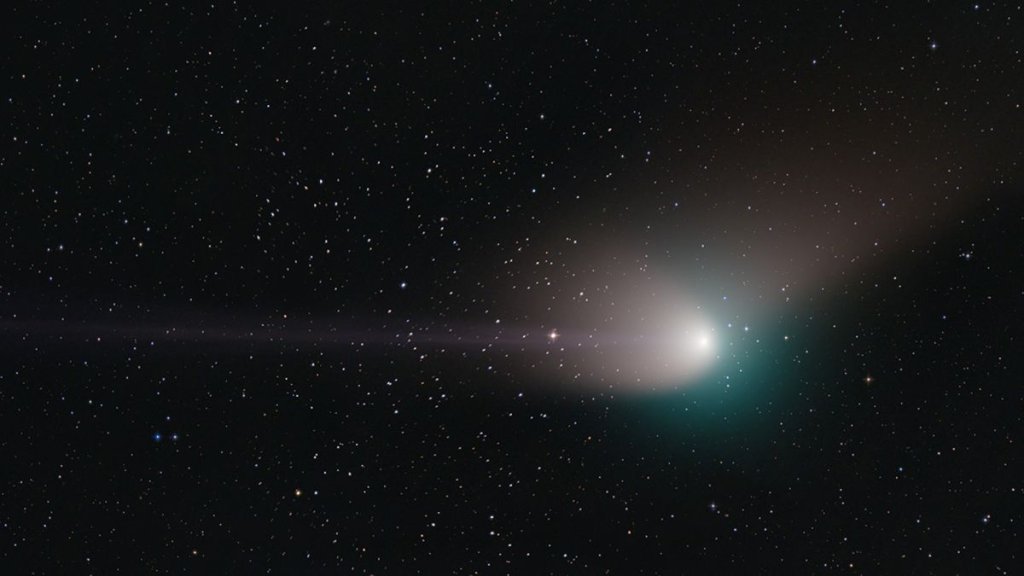
Watch the green comet pass the bright star Capella on Sunday (Feb. 5) (Image Credit: Space.com)
The naked eye comet C/2022 E3 has been causing quite the stir in 2023 thus far. On Sunday (Feb. 5) skywatchers who haven’t spotted the bright comet yet will get an excellent opportunity to do so as it passes the star, Capella, also known as the “Goat Star.”
Capella, Latin for “nanny goat,” also has the alternative name “Alpha Aurigae” due to the fact that it is the brightest star in the northern constellation of Auriga, the Charoiteer. In addition to this, Capella is also the sixth brightest star in the sky above Earth. It’s pushed down to seventh place if the sun is included in that ranking, however.
That makes the Goat Star, which is prominent on winter evenings, a great guide to assist in spotting C/2022 E3 (ZTF). During winter, the gold-hued star is high in the sky late in the evening.
Related: Green comet flaunts its tail in dazzling deep space photo
Read more: How to view and photograph comets

Looking for a telescope to see comet C/2022 E3 (ZTF)? We recommend the Celestron Astro Fi 102 (opens in new tab) as the top pick in our best beginner’s telescope guide.
C/2022 E3 (ZTF) moved into the constellation of Auriga, the Charioteer, on Wednesday (Feb. 1) just as it was making its close approach to Earth, or perigee. The comet has a period of 50,000 years meaning that the last time it came so close to Earth our planet was in the midst of a glacial period, or “ice age” and early homo sapiens shared its surface with Neanderthals.
To find the comet from New York City, look to the north in the evening hours after sunset and locate Auriga. Capella will be the brightest star in the constellation.

Comet C/2022 E3 (ZTF) will be in close proximity to Capella throughout the evenings of Sunday (Feb. 5) and Monday (Feb. 6), although it will have moved slightly away from the star by Monday.
The comet might be visible to the unaided eye in some dark sky locations, although any details will be difficult to make out. Through binoculars, skywatchers should be able to make out the faint greenish glow of the comet’s coma. Through a telescope, even more details should be discernible, depending on one’s equipment and skill.

Though Capella may appear as one star in the night sky to the naked eye it is actually composed of a system of four stars located around 42 light-years away from Earth; two systems that contain large binary stars, and two faint binary dwarf stars.
One of the binaries, the primary or “A” star of the Capella system consists of Capella Aa and Capella Ab, both giant yellow stars with masses around 2.5 times the size of the sun and are reaching the end of their natural lives after exhausting the hydrogen at their core, the fuel for nuclear fusion. This has led to them swelling out to around 10 times the size of the sun.
The secondary binary pairing of Capella is Capella H and Capella L, both of which are small and relatively cool red dwarfs that are located around 10,000 astronomical units (AU) from the larger binary system, with 1 AU equivalent to the distance between the sun and Earth.
Following this meeting of C/2022 E3 (ZTF) with the Goat Star Capella, the green comet will visit Mars and should be visible close by the Red Planet from Thursday (Feb. 9) for four days until Feb. 13.
If you’re hoping to catch C/2022 E3 (ZTF) as it visits Capella, our guides for the best telescopes and best binoculars are a great place to start. If you’re looking to snap photos of the green comet, check out our guide on how to view and photograph comets, as well as our best cameras for astrophotography and best lenses for astrophotography.
Editor’s Note: If you snap C/2022 E3 close to Capella, and would like to share it with Space.com’s readers, send your photo(s), comments, and your name and location to spacephotos@space.com.
Follow us @Spacedotcom, or on Facebook and Instagram.





